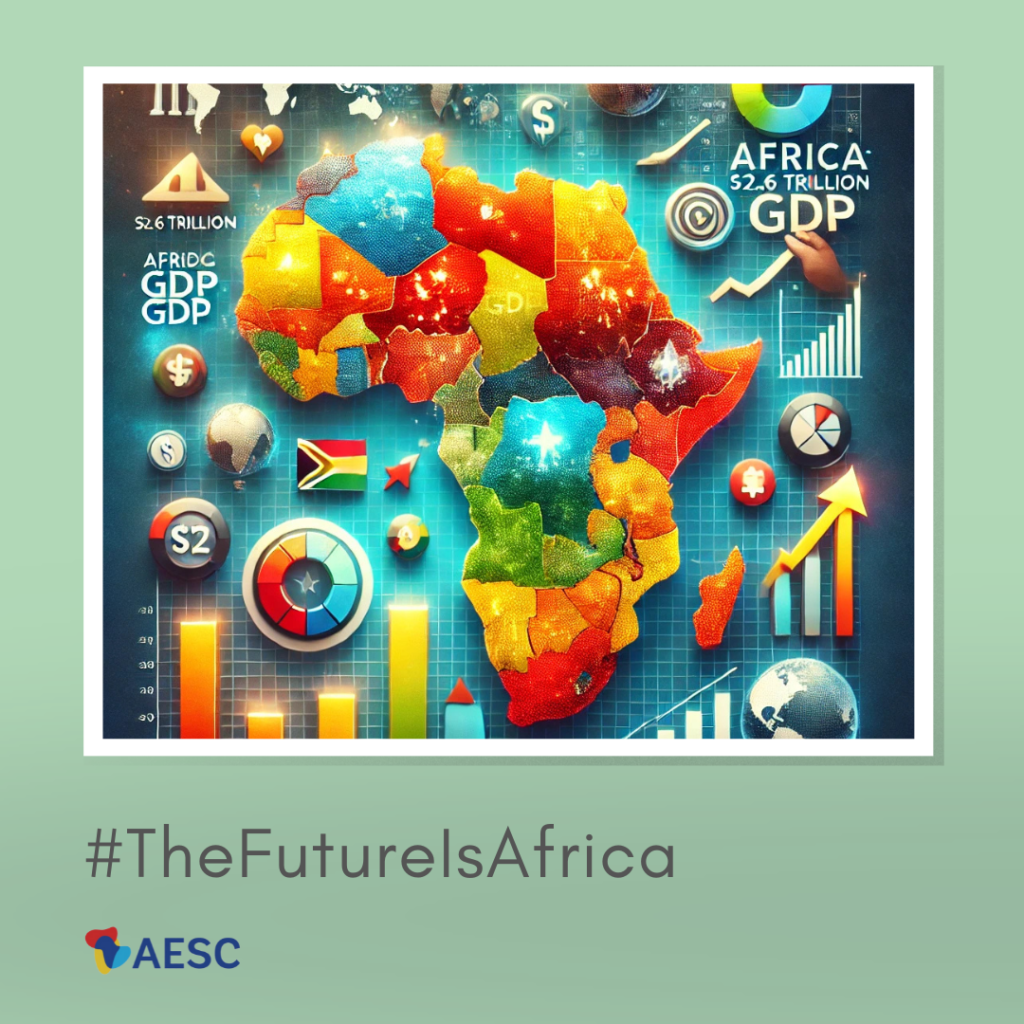
Economic Growth: Africa’s Transformative Trajectory
Africa’s economic growth over the past two decades has been remarkable, and this momentum is expected to continue, making the continent a critical pillar of global economic development. With a collective GDP currently standing at approximately $2.6 trillion and several countries experiencing high GDP growth rates, Africa is increasingly seen as an engine of opportunity. This growth, driven by rising commodity prices, improved macroeconomic management, and increased foreign investment, underscores why the future is deeply connected to Africa’s economic trajectory. As the continent continues to diversify its economy and strengthen its financial systems, it is poised to be a significant player in global markets, fostering a new era of prosperity and stability.
1. Africa’s GDP Growth: A Positive Outlook
Africa’s collective GDP of $2.6 trillion reflects the continent’s significant economic strides, particularly over the last two decades. Countries such as Nigeria, Egypt, South Africa, Kenya, and Ghana have emerged as economic powerhouses, demonstrating robust GDP growth fuelled by dynamic sectors like energy, agriculture, technology, and services. The International Monetary Fund (IMF) and the African Development Bank (AfDB) have both projected that Africa’s GDP growth rate will continue to outperform many other regions globally, driven by a young and growing population, an expanding middle class, and increasing urbanization.
Countries like Ethiopia, Rwanda, and Côte d’Ivoire have consistently posted GDP growth rates above 6% annually, placing them among the fastest-growing economies in the world. These growth rates reflect both the natural resource wealth and the diversification efforts underway in several African economies. Nigeria, Africa’s largest economy, has benefited from its oil exports while simultaneously investing in sectors such as telecommunications and technology, which have become increasingly vital contributors to GDP. Egypt has also expanded its economy through substantial reforms and investments in infrastructure, further diversifying its economy beyond traditional sectors like agriculture and tourism.
This upward trend in GDP growth is not a coincidence but rather the outcome of intentional macroeconomic reforms, improved governance, and proactive engagement with global markets. Africa’s ability to sustain this momentum will be pivotal for its future development and global influence.
2. Rising Commodity Prices: Boosting African Economies
Africa’s natural resource wealth remains a cornerstone of its economic growth. Rising global commodity prices, especially for oil, minerals, and agricultural products, have fuelled economic expansion in several African nations. The continent is home to 30% of the world’s mineral resources, including key inputs such as cobalt, gold, platinum, and copper, which are essential for industries ranging from electronics to green technology. This abundance has led to increased export revenues and investment flows, creating a platform for growth.
In oil-rich countries like Nigeria and Angola, higher oil prices have bolstered national revenues, allowing for investments in infrastructure and public services. Similarly, mineral-rich nations such as the Democratic Republic of Congo (DRC) and Zambia have capitalized on high global demand for metals like cobalt and copper, which are critical for electric vehicles and renewable energy technologies. This surge in demand, particularly for resources linked to the green economy, positions Africa as an indispensable player in the global supply chain, further enhancing its economic significance.
However, the dependency on commodity exports has also highlighted the need for diversification to protect against price volatility. African countries are increasingly aware of this challenge and are investing in other growth sectors such as manufacturing, technology, and agriculture, ensuring a more balanced and resilient economic future.
3. Improved Macroeconomic Management: Strengthening Economic Foundations
A key factor behind Africa’s sustained economic growth is the improvement in macroeconomic management across the continent. Over the past two decades, African governments have undertaken reforms to stabilize inflation, reduce debt, and manage fiscal policy more effectively. This shift towards prudent macroeconomic policies has created an environment conducive to investment and growth.
Many African nations have also worked to strengthen their central banks and financial institutions, focusing on maintaining stable currencies and managing inflation. For example, countries like Ghana and Kenya have implemented robust monetary policies that have kept inflation in check and maintained currency stability, which has, in turn, boosted investor confidence. Additionally, nations such as Rwanda and Ethiopia have made significant strides in enhancing fiscal transparency and reducing corruption, earning them high ratings on the World Bank’s Ease of Doing Business index.
The improved economic governance has created a stable and predictable environment that attracts both foreign and domestic investment. By establishing clearer regulations, enhancing property rights, and reducing bureaucratic barriers, African countries have laid the groundwork for long-term growth and stability.
4. Increased Foreign Investment: Catalysing Growth and Development
Foreign direct investment (FDI) has played a crucial role in Africa’s economic growth, providing capital for development projects, infrastructure, and industrialization efforts. Between 2020 and 2023, FDI flows to Africa increased steadily, particularly in sectors like manufacturing, technology, and energy. Countries such as Nigeria, Egypt, South Africa, and Ethiopia have become major recipients of FDI, with investments coming from diverse sources, including China, the European Union, the United States, and regional players.
China’s Belt and Road Initiative (BRI) has significantly impacted African economies by financing infrastructure projects like railways, highways, and ports, which are critical for trade and economic growth. These investments not only enhance connectivity within and beyond the continent but also stimulate job creation and local enterprise development. Similarly, investments from European and American companies in sectors like renewable energy, agriculture, and telecommunications are creating new industries and expanding Africa’s economic base.
Increased FDI has also led to technology transfer and skill development, further enhancing Africa’s human capital and enabling the continent to move beyond extractive industries. Investments in startups and technology hubs in cities like Lagos, Nairobi, and Cape Town demonstrate Africa’s growing role in the global tech economy. These hubs are fostering innovation and entrepreneurship, positioning Africa as a leading destination for tech talent and digital solutions.
5. The Path Forward: Building on Growth for Sustainable Development
While Africa’s economic growth is impressive, the future depends on building sustainable and inclusive economic models that benefit a broad spectrum of the population. Diversifying economies away from an overreliance on commodities is essential. Governments across Africa are actively pursuing industrial policies that focus on value addition in agriculture, expansion of manufacturing capabilities, and the development of service industries, particularly in finance and technology.
Trade integration is another area of focus, with the African Continental Free Trade Area (AfCFTA) being a landmark initiative aimed at boosting intra-African trade and economic cooperation. By reducing tariffs and harmonizing trade regulations, the AfCFTA seeks to create a single market of over 1.3 billion people, offering opportunities for businesses to expand and for economies to become more interconnected. This trade integration is expected to increase Africa’s GDP by over $450 billion by 2035, according to the World Bank, and could further stimulate economic growth and development.
Investing in human capital is also crucial for sustaining growth. Africa’s young and growing population is a demographic advantage, but it must be matched with education, vocational training, and job creation efforts to harness its potential fully. Countries like Kenya and Ghana are leading initiatives to boost education in technology and entrepreneurship, which are essential for building a resilient, knowledge-based economy.
Conclusion
Africa’s economic growth story is both significant and promising. With a collective GDP of $2.6 trillion and several countries posting high growth rates, the continent is on a trajectory that could redefine global economic dynamics. Rising commodity prices, improved macroeconomic management, and increased foreign investment have all contributed to this growth. However, the key to sustaining and expanding this growth lies in diversification, trade integration, and investment in human capital. By addressing these areas, Africa can solidify its role as a major economic force, making its future a focal point for global development.



